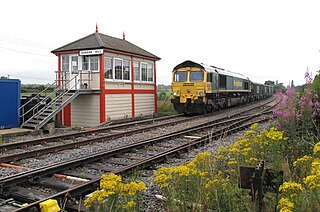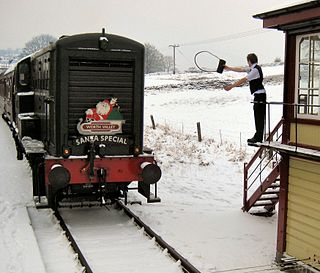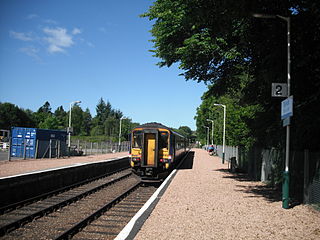
On a rail transport system, signalling control is the process by which control is exercised over train movements by way of railway signals and block systems to ensure that trains operate safely, over the correct route and to the proper timetable. Signalling control was originally exercised via a decentralised network of control points that were known by a variety of names including signal box, interlocking tower and signal cabin. Currently these decentralised systems are being consolidated into wide scale signalling centres or dispatch offices. Whatever the form, signalling control provides an interface between the human signal operator and the lineside signalling equipment. The technical apparatus used to control switches (points), signals and block systems is called interlocking.
Rail terminology is a form of technical terminology. The difference between the American term railroad and the international term railway is the most significant difference in rail terminology. There are also others, due to the parallel development of rail transport systems in different parts of the world.

In railway signalling, a token is a physical object which a train driver is required to have or see before entering onto a particular section of single track. The token is clearly endorsed with the names of the section it belongs to. A token system is more commonly used for single lines because of the greater risk of collision in the event of a mistake being made by a signaller or traincrew, than on double lines.

In railway signalling, an interlocking is an arrangement of signal apparatus that prevents conflicting movements through an arrangement of tracks such as junctions or crossings. The signalling appliances and tracks are sometimes collectively referred to as an interlocking plant. An interlocking is designed so that it is impossible to display a signal to proceed unless the route to be used is proven safe.

Brimsdown railway station is on the Lea Valley line that forms part of the West Anglia Main Line, serving the neighbourhood of Brimsdown in the London Borough of Enfield, north London. It is 10 miles 61 chains (17.3 km) down the line from London Liverpool Street and is situated between Ponders End and Enfield Lock. Its three-letter station code is BMD and it is in Travelcard zone 5.

Arrochar and Tarbet railway station is a railway station on the West Highland Line in Scotland. It stands between the villages of Arrochar and Tarbet.

Bodmin Parkway railway station is on the Cornish Main Line that serves the nearby town of Bodmin and other parts of mid-Cornwall, England. It is situated 3 miles (4.8 km) south-east of the town of Bodmin in the civil parish of St Winnow, 274 miles 3 chains from London Paddington measured via Box and Plymouth Millbay.
Australian railway signalling varies between the states of Australia, because each railway system was established under the different colonial governments with separate legislation. Just as with the notorious variation of Australian rail gauges, there are differing signal systems. The systems in New South Wales generally follow British precedents, although American influence has increased somewhat since the 1990s. Victoria uses American-style speed signalling on its main lines. That can cause confusion where the systems meet.

Bridge of Orchy railway station is a railway station in the village of Bridge of Orchy in the west of Scotland. This station is on the West Highland Line. Being an island platform, access is via a subway.

Taynuilt railway station is a railway station serving the village of Taynuilt in western Scotland. This station is on the Oban branch of the West Highland Line, originally part of the Callander and Oban Railway.
The Connington South rail crash occurred on 5 March 1967 on the East Coast Main Line near the village of Conington, Huntingdonshire, England. Five passengers were killed and 18 were injured.

Mechanical railway signalling installations rely on lever frames for their operation to interlock the signals, track locks and points to allow the safe operation of trains in the area the signals control. Usually located in the signal box, the levers are operated either by the signalman or the pointsman.

Claydon railway station is a former railway station on the 'Varsity Line', that served the village of Steeple Claydon in Buckinghamshire.

Railway semaphore signal is one of the earliest forms of fixed railway signals. This semaphore system involves signals that display their different indications to train drivers by changing the angle of inclination of a pivoted 'arm'. Semaphore signals were patented in the early 1840s by Joseph James Stevens, and soon became the most widely used form of mechanical signal. Designs have altered over the intervening years, and colour light signals have replaced semaphore signals in most countries, but in a few they remain in use.

Congupna is a closed railway station on the Goulburn Valley railway line, in the township of Congupna, just north of Shepparton, Victoria, Australia. The station opened as Congupna Road at the same time as the railway from Shepparton to Numurkah on 1 September 1881, and was renamed Congupna in February 1968.
The Battersea Park rail crash occurred on 2 April 1937, just south of Battersea Park railway station on the Southern Railway, in London. Two electrically driven passenger trains collided on the Up Local line; the second train, from Coulsdon North to Victoria, had been allowed into the section while it was still occupied by the first train, from London Bridge to Victoria. The signalman at Battersea Park, G. F. Childs, believing there was a fault with the Sykes electromechanical interlocking apparatus which was installed at the box, had opened up the case of the instrument and inadvertently cleared the interlock which should have prevented this situation. The official enquiry ruled that he subsequently accepted the Coulsdon train, although he should have been aware that the London Bridge train had not cleared the section. Ten people were killed, including the guard of the London Bridge train, and eighty people were injured, seven sustaining serious injuries. Another accident had occurred at Battersea Park in 1881.

Lechlade railway station served the small town of Lechlade in Gloucestershire, England. The station was on the Oxford, Witney and Fairford Railway, between Oxford and Fairford, it was built where the line crossed the road to Burford, 0.5 miles (0.80 km) north of Lechlade.
The Kirtlebridge rail crash took place in 1872 at Kirtlebridge railway station in Dumfriesshire. An express passenger train ran into a goods train that was shunting; 11 people lost their lives immediately, and one further person succumbed later. The cause was a failure to communicate between the station master in charge of the shunting operation, and the signalman. There was not full interlocking of the points, and the block system of signalling was not in use.
The Lincolnshire Wolds Railway Signals and Telecommunications Department is a railway department on the preserved heritage railway in Lincolnshire, England. It installs, maintains and repairs all the signalling and telecommunications on the LWR. Based primarily at Ludborough, the department looks after the railways two functioning signal boxes at Ludborough and North Thoresby.

The Signals, Crane and Subway are heritage-listed railway infrastructure at Charters Towers railway station, Enterprise Road, Charters Towers, Charters Towers Region, Queensland, Australia. They were added to the Queensland Heritage Register on 30 October 2008.














